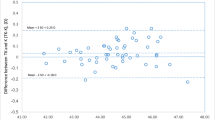Abstract
Background
Precise IOL calculation in post-refractive surgery patients is still a challenge for the cataract surgeon. The purpose of this study is to test whether adding Orbscan II values into the double-K method improves IOL calculation in this group of patients.
Methods
A prospective study with 43 eyes previously submitted to refractive surgery that underwent cataract extraction. IOL calculation was performed with double-K method. Post-K value was derived from Orbscan total-mean power map. The average corneal curvature of the general population (43.8D) was used as the pre-K value. Refraction results 30 days after surgery were compared with refraction that would be obtained if we used: (1) post-K values from keratometry, (2) post-K values from topography, and (3) pre-K values from Orbscan total-mean power. Anterior chamber depth measures obtained with the IOL Master and Orbscan II were compared.
Results
Mean postoperative spherical equivalent (SE) was −0.25 ± 1.10 D in eyes submitted to radial keratotomy , –1.04 ± 1.42 D in eyes previously submitted to myopic Lasik, and +0.05 ± 1.76 D in those submitted to hyperopic surgeries. Had we inputted post-K values derived from keratometer and from topography, we would have obtained significantly higher postoperative refractive errors in eyes previously submitted to myopic refractive surgery (p < 0.05). Refractions using pre-K derived from the central 8 mm Orbscan instead of 43.8 D were similar in all studied groups (p > 0.05). Anterior chamber depth measured with IOL Master or Orbscan were similar.
Conclusions
Orbscan measurements used as the post-K values into the double-K method provide a precise IOL calculation, especially in post myopic refractive surgery patients.
Similar content being viewed by others
References
Koch DD, Liu JF, Hyde LL, Rock RL, Emery JM (1989) Refractive complications of cataract surgery after radial keratotomy. Am J Ophthalmol 108:676–682
Gimbel HV, Sun R (2001) Accuracy and predictability of intraocular lens power calculation after laser in situ keratomileusis. J Cataract Refract Surg 27:571–576
Hoffer KJ (2009) Intraocular lens power calculation after previous laser refractive surgery. J Cataract Refract Surg 35:759–765
Ho JD, Liou SW, Tsai RJF, Tsai CY (2008) Estimation of effective lens position using a rotating Scheimpflug camera. J Cataract Refract Surg 34:2119–2127
Qazi MA, Cua IY, Roberts CJ, Pepose JS (2007) Determining corneal power using Orbscan II videokeratography for intraocular lens calculation after excimer laser surgery for myopia. J Cataract Refract Surg 33:21–30
Borasio E, Stevens J, Smith GT (2006) Estimation of true corneal power after keratorefractive surgery in eyes requiring cataract surgery: BESSt formula. J Cataract Refract Surg 32:2004–2014
Aramberri J (2003) Intraocular lens power calculation after corneal refractive surgery: double-K method. J Cataract Refract Surg 29:2063–2068
Feiz V, Mannis MJ, Garcia-Ferrer F, Kandavel G, Darlington JK, Kim E, Caspar J, Wang W (2001) Intraocular lens power calculation after laser in situ keratomileusis for myopia and hyperopia: a standardized approach. Cornea 20:792–797
Sónego-Krone S, López-Moreno G, Beaujon-Balbi OV, Arce CG, Schor P, Campos M (2004) A direct method to measure the power of the central cornea after myopic laser in situ keratomileusis. Arch Ophthalmol 122:159–166
Maidana EJ, Alzamora JB, Arce CG, Schor P, Campos M (2005) Método para determinar cuál era el poder central de la córnea antes de la cirugía refractiva de miopía. Presented at: XXV Pan American Congress of Ophthalmology, March 18-21,Santiago, Chile
Gelender H (2006) Orbscan II-assisted intraocular lens power calculation for cataract surgery following myopic laser in situ keratomileusis. Trans Am Ophthalmol Soc 104:402–413
Arce CG, Soriano ES, Weisenthal RW, Hamilton SM, Rocha KM, Alzamora JB, Maidana EJ, Vadrevu VL, Himmel K, Schor P, Campos M (2009) Calculation of intraocular lens power using Orbscan II quantitative area topography after corneal refractive surgery. J Refract Surg 25:1061–1074
Savini G, Barboni P, Profazio V (2008) Corneal power measurements with the Pentacam Scheimpflug camera after myopic excimer laser surgery. J Cataract Refract Surg 34:809–813
Packer M, Brown LK, Hoffman RS, Fine IH (2004) Intraocular lens power calculation after incisional and thermal keratorefractive surgery. J Cataract Refract Surg 30:1430–1434
Shammas HJ, Shammas MC, Garabet A, Kim JH, Shammas A, LaBree L (2003) Correcting the corneal power measurements for intraocular lens power calculations after myopic laser in situ keratomileusis. Am J Ophthalmol 136:426–432
Garg A (2005) Optical biometry with IOL Master. In: Garg A, Hoyos JE, Dementiev D (eds) Mastering techniques of IOL power calculations. Jaypee Brothers, New Delhi, pp 51–54
Cairns G, McGhee CNJ (2005) Orbscan computerized topography: attributes, applications, and limitations. J Cataract Refract Surg 31:205–220
Reddy AR, Pande MV, Finn P, El-Gogary H (2004) Comparative estimation of anterior chamber depth by ultrasonography, Orbscan II, and IOL Master. J Cataract Refract Surg 30:1268–1271
Wang L, Booth MA, Koch DD (2004) Comparison of intraocular lens power calculation methods in eyes that have undergone LASIK. Ophthalmology 111:1825–1831
Shammas HJ, Shammas MC (2007) No-history method of intraocular lens power calculation for cataract surgery after myopic laser in situ keratomileusis. J Cataract Refract Surg 33:31–36
Haigis W (2008) Intraocular lens calculation after refractive surgery for myopia: Haigis-L formula. J Cataract Refract Surg 34:1658–1663
Masket S, Masket SE (2006) Simple regression formula for intraocular lens power adjustment in eyes requiring cataract surgery after excimer laser photoablation. J Cataract Refract Surg 32:430–434
Author information
Authors and Affiliations
Corresponding author
Additional information
The authors do not have any financial interest.
Rights and permissions
About this article
Cite this article
Kwitko, S., Marinho, D.R., Rymer, S. et al. Orbscan II and double-K method for IOL calculation after refractive surgery. Graefes Arch Clin Exp Ophthalmol 250, 1029–1034 (2012). https://doi.org/10.1007/s00417-012-1974-z
Received:
Revised:
Accepted:
Published:
Issue Date:
DOI: https://doi.org/10.1007/s00417-012-1974-z




